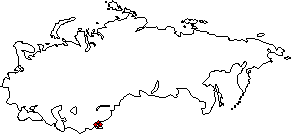CONTENTS
IntroductionForeword
Language Groups
Tribes and Dialects
Order the book
The Peoples
of the Red Book
Abazians (Abaza)Abkhaz
Aguls
Akhvakhs
Aleuts
Altaics
Aliutors
Andis
Archis
Asiatic Eskimos
Bagulals
Baraba Tatars
Bartangs
Bats
Bezhtas
Botlikhs
Budukhs
Central Asian Jews
Chamalals
Chukchis
Chulym Tatars
Crimean Jews
Crimean Tatars
Didos
Dolgans
Enets
Evens
Evenks
Georgian Jews
Godoberis
Hinukhs
Hunzibs
Ingrians
Ishkashmis
Itelmens
Izhorians
Kamas
Karaims
Karatas
Karelians
Kereks
Kets
Khakass
Khants
Khinalugs
Khufis
Khvarshis
Kola Lapps
Koryaks
Kryz
Kurds
Lithuanian Tatars
Livonians
Mansis
Mountain Jews
Nanais
Negidals
Nenets
Nganasans
Nivkhs
Nogays
Orochis
Oroks
Oroshoris
Peoples of the Pamirs
Roshanis
Rutuls
Selkups
Shors
Shughnis
Tabasarans
Talysh
Tats (Tatians)
Tindis
Tofalars
Trukhmens (Turkhmens)
Tsakhurs
Udeghes
Udis
Ulchis
Veps
Votes
Wakhs
Yaghnabis
Yazgulamis
Yukaghirs

THE SHUGHNIS
Habitat. The Shughnis inhabit the right bank of the River Pyandzh, from the village of Darmoraht to the village of Dashti, (on other evidence, from Sohtsharv to Khasharag), also the valleys of the Shokhdar (Shakh-Dar) and Gund (Gunt), two rivers which converge at the town of Khorog and flow into the Pyandzh. The Bajuvi people, generally supposed to be part of the Shughnis, live in the valley of the River Bajuvi. Administratively, the area belongs to the Shughni district of the Gorno-Badakhshan autonomous region in Tadzhikistan (centre, Khorog), and the Rosht-Kala district ( centre, Rosht-Kala). About ten of the villages (qishlaqs) have been evacuated (Andravdj, Morkhona, Marchid, etc.). A part of the Shughnis have been resettled in the Garant village of the Kolkhozabad district. The place-names illustrate how in many places in Badakhshan the Shughni language has had to retreat before the Tadzhik language (in the valley of Garmchashma for example). The border set by the Soviet Union bisects the territory of the Shughnis, so that the Shughnis on the left bank of the River Pyandzh belong to Afghanistan.
Language. The Shughni language, together with the Roshani, Khufi, Bartangi, Oroshori and Sarikoli languages, forms the Shughni-Roshani or northern group of the Pamir languages of the Iranian group of the Indo-European family of languages. These languages are so close to each other that mutual understanding presents no difficulties. Shughni-speakers form the largest grouping within these languages and they are the largest of the Pamir Iranian-speaking minorities, constituting over a half of all Pamir smaller peoples. Although the Shughnis and their language attracted academic interest earlier than other Pamir peoples, scarcely any literature or publications exist on them. The first published data concerning the Shughni language appeared in an article by R. Shaw "On the Shighni (Ghalchah) Dialect" (Journal of the Asiatic Society of Bengal, vol. 46, 1877). The Shughni language, including the dialects of Bajuvi (Bajui) and Shakhdar, is also spoken outside of the ex-Soviet territories, in the Afghan Badakhshan. A considerable number of Shughnis live in Kabul, although they are becoming assimilated.
Population. According to a 1926 census, there were 21,000 Shughnis, by 1939 -- 18,600 (according to other data, 13,000--15,000) and 500 speakers of the Bajuvi dialect. About the same number of Shughnis are thought to live in Afghanistan.
The Shughnis, as well as the Wakhs, belong to the Ismailites and the Soviet regime did its utmost to hasten the Shughnis, assimilation with the Tadzhiks.
A Shughni script was created in 1930/31 on the basis of the Latin alphabet. A number of textbooks and teaching devices were compiled and some of them were even published. However, the Shughnis were only able to benefit from native language schooling for a few years. The researcher of place-names, R. Dodykhudoyev, notes that native schooling of the Shughnis was undesirable, "considering the ultimate aim, namely, establishing a unified educational system throughout the territory of Tadzhikistan" (1975). He commented further that no Pamir language had any real prospect of being used for schooling; none of these languages were destined to find a place on any future linguistic map. The situation with the Shughni language was somewhat more complicated, admitted R. Dodykhudeyev (1975). The collective body of Shughni-speakers is the largest among all Pamir languages. Shughnan is also the administrative centre and the most industrially developed area in the Pamir (Gorno-Badakhshan) district. Therefore, the Shughni language, together with the Tadzhik language, has become a peculiar lingua franca for the Pamir region. All people, irrespective of nationality, who have come to work or study in the town of Khorog speak Shughni. Although the Shughni districts form only 15 % of the area of Gorno-Badakhshan, about one third of the entire population of the autonomous region live there. About a quarter of the population of the autonomous region of Gorno-Badakhshan live in Khorog. The proportion of non-Pamir peoples in Khorog, Russians included, is high.
History. Shughni men are accustomed to finding jobs outside their own region, in the towns of Eastern Bukhara, Fergana, Afghanistan and in Pakistani Chitral. At the present time, the centre of the autonomous region of Gorno-Badakhshan, Khorog, is situated in Shughnan. Not far from here is the historical capital of Badakhshan, Faizabad, a major centre for trade and culture, nowadays located over the border in Afghanistan.
Shughnan was mentioned in Chinese chronicles of the 6th--7th centuries. The ancient Shughnis always kept the trade route through Shughnan under their control. Legends of savage and warlike Shughnis who used to raid caravans, have still survived to the present day.
REFERENCES
- Р. Х. Додыхудоев, Памирская микротопонимия, Душанбе 1975
- Д. Карамшоев, Баджувский диалект шугнанского языка, Душанбе 1963
- И. И. Зарубин, Шугнанские тексты и словарь, Москва -- Ленинград 1960
LV
shors | shughnis | tabasarans